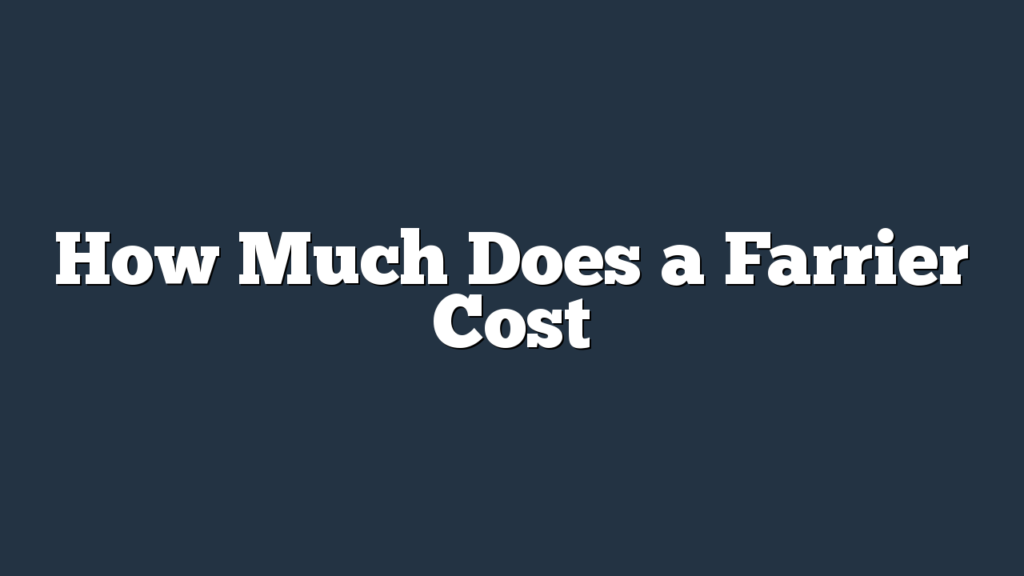Are you curious about how much a farrier will cost you? Look no further! In this article, we will explore the various factors that affect farrier costs, such as your location, horse size and breed, and the different services offered by farriers.
We will also discuss additional costs associated with specialized treatments and the importance of regular maintenance. By understanding the pricing structure and following our tips, you can find an affordable and reliable farrier for your equine companion.
Factors That Affect Farrier Costs
When considering the cost of a farrier, there are several factors that will influence the final price you can expect to pay. One such factor is geographical pricing variations. Farrier services may cost more in certain areas due to higher living expenses or increased competition. For example, in urban areas where the cost of living is generally higher, farriers may charge higher rates to cover their expenses. On the other hand, in rural areas where there may be fewer farriers available, the prices may be lower due to less competition.
Another factor that can affect farrier costs is breed specific hoof care. Different horse breeds have unique hoof care requirements, and this can impact the cost of farrier services. For instance, certain breeds may have more delicate hooves that require special attention and maintenance, which could result in higher prices. Additionally, some breeds may have specific shoeing needs, such as draft horses or performance horses, which may require specialized equipment and expertise, leading to increased costs.
It is important to keep these factors in mind when budgeting for farrier services. By considering geographical pricing variations and breed specific hoof care, you can better understand the factors that can influence the cost of a farrier and ensure you’re prepared for the expenses involved.
Location and Its Impact on Pricing
When it comes to the cost of a farrier, one important factor to consider is location. The prices for farrier services can vary significantly depending on the geographic area.
In rural areas, where there may be fewer farriers available, the costs can be higher due to increased travel expenses and limited competition.
Conversely, in urban areas with more farriers, the prices may be more competitive.
Geographic Price Variations
To understand how geographic location impacts the cost of a farrier, it’s important for you to consider different factors that influence pricing.
Geographic price comparisons reveal significant differences in the cost of farrier services across different regions. International pricing differences also play a role in determining the cost of a farrier.
These variations can be influenced by factors such as the cost of living in a particular area, supply and demand dynamics, and local competition. In some areas, where the cost of living is higher, farriers may charge more for their services to compensate for their expenses.
Additionally, international pricing differences can be influenced by currency exchange rates and the cost of importing or exporting farrier equipment and supplies.
Rural Vs. Urban Costs
Geographic location significantly affects the cost of a farrier, with rural and urban areas having distinct pricing differences.
When it comes to rural vs. urban pricing, various factors come into play. In rural areas, where there may be fewer farriers available, the cost tends to be higher due to limited competition. The farrier may have to travel longer distances, which can also contribute to the increased price.
On the other hand, in urban areas, there’s usually a higher concentration of farriers, leading to more competition and potentially lower prices. Additionally, the cost of living in urban areas tends to be higher, which can also impact the overall pricing.
Therefore, it’s essential to consider the impact of location on costs when determining the expense of hiring a farrier.
The Importance of Horse Size and Breed
When it comes to horse size and breed, it’s important to consider their specific shoeing needs.
Larger horses often require more materials and time to trim and shoe, which can impact the overall cost.
Additionally, different breeds may have specific hoof care requirements, such as certain shoeing techniques or specialized treatments.
Taking into account these factors can help determine the appropriate cost for farrier services based on the size and breed of your horse.
Size and Shoeing Needs
If you own a horse, you’ll want to consider their size and breed when determining their shoeing needs.
The size of your horse plays a significant role in the type of shoes they require. Larger breeds, such as draft horses or warmbloods, may need heavier shoes to provide adequate support and protection. On the other hand, smaller horses like ponies or miniature horses may require lighter shoes to prevent discomfort or strain.
Additionally, different breeds may have specific shoeing needs based on their conformation and movement. For example, thoroughbreds may benefit from shoes that provide extra traction and support for their high-speed activities, while gaited breeds may require specialized shoes to enhance their unique gaits.
Considering your horse’s size and breed will ensure that their shoeing needs are met, promoting their overall comfort and well-being.
Breed-Specific Hoof Care
Consider your horse’s size and breed when it comes to breed-specific hoof care. Different horse breeds have unique characteristics that require specialized treatments for their hooves. For example, larger breeds like draft horses have heavier bodies and larger hooves, which require extra support and care. On the other hand, smaller breeds like ponies may have more delicate hooves that need careful attention. To illustrate the importance of breed-specific hoof care, consider the following table:
| Breed | Hoof Care Needs | Specialized Treatments |
|---|---|---|
| Thoroughbred | Regular trimming and shoeing | Hoof supplements for hoof health |
| Arabian | Frequent hoof cleaning and trimming | Hoof boots for protection |
| Clydesdale | Extra support and corrective shoeing | Pad and wedge inserts for stability |
| Shetland Pony | Regular trimming and monitoring for laminitis | Hoof moisturizers for hoof strength |
| Friesian | Frequent trimming and shoeing for hoof balance | Hoof packing for protection and support |
Understanding the specific needs of your horse’s breed will ensure that they receive the appropriate hoof care and specialized treatments they require.
Different Services Offered by Farriers
A farrier offers a variety of specialized services for your horse’s hoof care. Here are three essential services provided by farriers:
- Trimming and balancing: Farriers are trained to trim and balance your horse’s hooves. This service ensures that the hooves are properly shaped and aligned, promoting healthy movement and reducing the risk of lameness.
- Shoeing: Farriers can also provide shoeing services, where they attach horseshoes to your horse’s hooves. This helps protect the hooves from excessive wear and tear, provides additional support, and can address specific hoof issues or injuries.
- Therapeutic hoof care: Farriers with advanced qualifications can offer therapeutic hoof care for horses with specific hoof problems, such as lameness or hoof diseases. They may use specialized techniques, materials, and shoeing methods to alleviate pain, promote healing, and improve the overall hoof health of the horse.
Farrier qualifications play a crucial role in ensuring the quality of these services. A skilled and experienced farrier should have completed formal training, such as a farrier apprenticeship or certification program. They should also stay updated on the latest industry standards and techniques through continuing education. By choosing a qualified farrier, you can trust that your horse’s hoof care needs will be met with expertise and professionalism.
Additional Costs Associated With Specialized Treatments
When seeking specialized treatments for your horse, you should be aware of the additional costs associated with these services. While the cost of basic farrier services may be relatively straightforward, specialized treatment options can add to the overall expense. One important factor to consider is the cost of medication. Depending on the condition being treated, your horse may require specific medications or supplements that can increase the total cost of the treatment.
To give you a better understanding of the potential costs involved, here is a table outlining some common specialized treatments and their associated costs:
| Specialized Treatment | Average Cost |
|---|---|
| Lameness Evaluation | $200 – $500 |
| Joint Injections | $300 – $600 |
| Shockwave Therapy | $400 – $800 |
| Platelet-Rich Plasma | $500 – $1,000 |
Please note that these costs are averages and can vary depending on factors such as location and the severity of the condition. It’s always a good idea to consult with your farrier or veterinarian to get an accurate estimate for your specific situation.
In addition to the cost of the specialized treatment itself, it’s important to consider any follow-up appointments or maintenance treatments that may be required. These can also contribute to the overall cost of the treatment.
The Significance of Regular Maintenance and Its Cost
Regular maintenance plays a crucial role in ensuring the overall health and well-being of your horse, and it comes with its own associated costs. While the expenses for regular maintenance may seem daunting, they’re a necessary investment in the long-term care of your horse.
Here are a few reasons why regular maintenance is significant and worth the cost:
- Prevention is key: Regular maintenance allows for early detection of potential issues, preventing them from escalating into more serious and costly problems down the line. By investing in routine check-ups, vaccinations, and dental care, you can catch and address any health concerns before they become major issues.
- Enhanced performance: Regular maintenance, such as proper hoof care and regular exercise, can greatly enhance your horse’s performance. By investing in the necessary treatments and exercises, you ensure that your horse stays in prime condition, leading to better results in competitions or recreational activities.
- Cost-saving measures: While regular maintenance may seem expensive in the short term, it actually helps you save money in the long run. By addressing minor issues early on, you can avoid costly treatments or surgeries that may be required if problems are left untreated.
Understanding the Pricing Structure of Farriers
To understand the pricing structure of farriers, you’ll need to familiarize yourself with the factors that contribute to the cost of their services. A number of pricing factors can affect the cost of hiring a farrier, leading to variations in the overall cost.
One of the main pricing factors is the type of service being provided. Basic services, such as trimming and shoeing, are generally more affordable compared to specialized services like corrective shoeing or therapeutic hoof care. The complexity of the job also plays a role in determining the cost. More challenging cases, such as horses with hoof deformities or lameness issues, may require additional time and expertise, resulting in higher fees.
Geographical location is another factor that can influence the cost of farrier services. In certain areas, where the cost of living is high or the demand for farriers is greater than the supply, prices may be higher. On the other hand, in areas with a lower cost of living or fewer farriers, the prices may be more competitive.
Furthermore, the experience and reputation of the farrier can impact the pricing structure. Farriers who’ve been in the industry for a long time and have built a strong reputation may charge higher fees for their expertise and skill.
It’s important to keep in mind that while cost variations exist, it’s crucial to prioritize the quality and expertise of the farrier over the price. A well-trained and experienced farrier can help maintain the overall health and soundness of your horse, ultimately saving you money in the long run.
Tips for Finding an Affordable and Reliable Farrier
To find an affordable and reliable farrier, start by asking fellow horse owners for recommendations. They can provide valuable insights and personal experiences with different farriers in your area. Here are some additional tips to help you in your search:
- Do your research: Take the time to research local farriers online and read reviews from other horse owners. Look for feedback on their reliability, professionalism, and quality of work. This will give you an idea of their reputation and if they’re trustworthy.
- Ask for references: When you narrow down your options, don’t hesitate to ask the farriers for references from their current clients. Speaking directly with these clients will give you a better understanding of the farrier’s skills and reliability.
- Negotiate pricing: Once you’ve found a trustworthy farrier, it’s time to discuss pricing. Don’t be afraid to negotiate and find a mutually beneficial arrangement. Some farriers may offer discounts for regular clients or multiple horses. Be open and honest about your budget while still acknowledging the farrier’s expertise and the value they provide.
Finding a trustworthy farrier at an affordable price is possible with some research and communication. By following these tips, you can ensure that your horse receives the best care without breaking the bank.
Frequently Asked Questions
Can I Learn How to Trim and Shoe My Own Horse to Save Money on Farrier Costs?
You can learn how to trim and shoe your own horse to save money on farrier costs. However, it’s important to consider the learning curve and time commitment involved in mastering these skills.
Are There Any Discounts or Package Deals Available for Multiple Horses?
When it comes to caring for multiple horses, you may be able to find discounts or package deals from farriers. Learning farrier skills, such as self-trimming, can also lead to cost savings in the long run. Additionally, using recommended hoof care products and understanding horseshoe lifespan and replacement frequency can help you manage the costs more effectively.
How Often Should I Have My Horse’s Hooves Trimmed or Shoes Reset?
To keep your horse’s hooves healthy, have them checked by a farrier every 6-8 weeks. As for shoeing, it’s generally recommended to start when the horse is around 1 year old.
Can a Farrier Provide Recommendations for Hoof Care Products or Supplements?
A farrier can definitely provide recommendations for hoof care products or supplements. They have the expertise to suggest the best products that will benefit your horse’s hooves and overall health.
What Is the Average Lifespan of Horseshoes, and How Often Do They Need to Be Replaced?
On average, horseshoes last about 6-8 weeks, but this can vary depending on factors like activity level and hoof condition. Look for signs of wear, like loose nails or cracks, and schedule replacement with your farrier as needed. Regular maintenance and cleaning can help extend their lifespan.
Conclusion
In conclusion, when it comes to farrier costs, various factors influence the pricing. Factors like location, horse size and breed, different services offered, specialized treatments, and regular maintenance all contribute to the overall cost.
It’s important to understand the pricing structure of farriers and to find a reliable and affordable one. By considering these factors and following the tips provided, you can find a farrier that meets your needs and budget.



